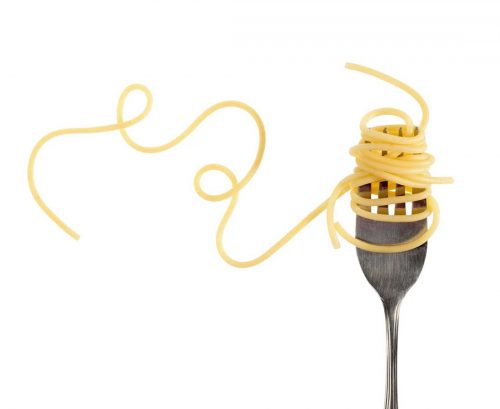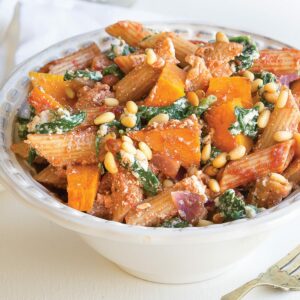
Are carbs really to blame for unwanted weight gain? And is there a way to cut back on carbs without missing out on them altogether? HFG shares the latest evidence on low-carb diets and weight loss.
Let’s be honest … many of us came out of isolation wearing a few extra kilos. And for some of us, they were unwelcome. All those loaves of homemade banana bread and cosy nights on the couch have resulted in what’s been dubbed the ‘COVID–15’ — something similar to the weight gain that happens in the first year of university.
Now, as we start to ease back to normality, some of us are feeling motivated to get back to a healthier weight range.
Fortunately, you don’t have to take drastic action to shed a few kilos. Growing evidence suggests a lower-carb eating pattern is one of the ways that help you manage your weight and regain energy, so you can get back to feeling your healthiest, happiest self. Here’s what you need to know.
Why we crave carbs
There’s a reason supermarket shelves were virtually emptied of basic staples like pasta, rice and baked beans when pandemic panic buying was roaring towards its peak back in March and April.
When we are stressed, high levels of cortisol can result in carb cravings, often in the form of refined carbohydrates and sweets. These foods also fire off feel-good chemicals like serotonin and dopamine, temporarily relaxing us.
This can become a vicious circle, however, where we consume the foods that will momentarily make us feel better, but actually make us feel worse in the long-term.
What is a low-carb diet?
When you hear the words ‘low carb’, you might instantly think of restrictive diets such as paleo or ketogenic. But reducing your carb intake doesn’t mean quitting carbs for good. There is such a thing as a happy balance.
The real problem is, there’s no universally agreed definition of what a low-carb diet is — but they are often defined as having 50g–130g carbs a day. That’s about one-third to half of what the current dietary guidelines recommend. By comparison, the keto diet recommends well below 50g carbs daily.
What happens when we eat carbs?
Carbs are the petrol that fuels the body’s engine. During the digestive process, the body breaks down carbs from food into sugar (glucose), which then moves into the bloodstream and into our cells for energy.
When we don’t eat enough carbs to maintain this steady glucose supply, we force our bodies to start using protein or fat for energy. This is a back-up system to see your body through a surprise famine, so it’s a less efficient process.
Glucose is also the main source of energy for the brain, so it’s key to our thinking and our memory. Plus, without carbs, our muscles lack the energy reserves to respond properly to emergencies. Carbs are essential to life!
But not all carbs are equal, and choosing the right ones can really make a big difference to your weight, if that’s a concern, and your mood and energy levels.
Where’s the science at?
One of the biggest dilemmas in nutrition science is collating the latest evidence on carbs into one-size-fits-all national dietary guidelines recommended by health professionals.
Current dietary guidelines recommend around 50 per cent of our daily kilojoule intake comes from unrefined carbohydrates that are high in fibre and have a low-glycaemic (GI) index.
These foods include wholegrain breads, pasta and cereals, legumes (chickpeas and lentils), fruit and starchy veg like potatoes. Most of us aren’t overdoing the amount of carbs we eat, but we could do better on quality.
However, with the increasing levels of inactivity, obesity and type 2 diabetes in developed countries, there’s growing evidence to suggest that reducing the amount of carbohydrates in our diet — in tandem with increasing the proportion of protein and healthy unsaturated fats — may be beneficial for some people.
Low-carb diets and weight loss
Some research suggests that, in the short-term, lower-carb diets appear to be a safe and effective option for weight loss, if that’s what you’re after.
In fact, some people find they lose weight more easily when they reduce their overall intake of carbohydrates.
However, when compared with other weight-loss approaches over longer time periods, low-carb diets do not appear to be superior.
Given that over 30 per cent of the average person’s daily kilojoule intake comes from discretionary foods, such as biscuits, fast food and chips, most of us could benefit from cutting back on these types of refined, processed carbs and replacing them with healthier options.
Low-carb diets and fibre
Going low-carb can make it difficult to meet your fibre requirements, which is why you should never cut out carbs completely.
Fibre — sourced primarily from fruit, veg, grain foods, nuts and seeds — is an essential part of a balanced diet. Research shows a high-fibre diet can help with healthy weight management, and fibre is essential to promote good gut health.
Evidence suggests that fibre from wholegrain foods is more effective in preventing weight gain when compared with fibre from fruit and vegetables.
So swapping white, refined carb-rich foods for wholegrain foods is a smart way to ensure you’re not missing out on fibre.
Low-carb diets and type 2 diabetes
Over 20 years of research by the CSIRO and other leading scientific bodies into the most effective way to manage type 2 diabetes found a lower-carb diet results in better blood glucose management, compared with a traditional higher-carb diet.
The CSIRO found that the low-carb group experienced greater reductions in their blood glucose levels, blood triglyceride levels, and ‘good’ HDL-cholesterol levels.
The low-carb group also experienced greater reductions in their need for diabetes medication.
As a result, the world’s leading health authorities now recognise and support the role of low-carb diets as part of an individualised approach in the management of type 2 diabetes.
6 ways to reduce your carbs healthily
1 Speak to your doctor and your dietitian before going low carb.
This is especially important if you’re on any medication for type 2 diabetes. Ideally, you should also be supported by a dietitian to ensure your diet is balanced and nutrient rich.
2 Aim to reduce sugary carbs, and carbs with a lot of saturated fat and/or salt.
These foods are usually high in kilojoules but not particularly rich in protein, fibre, vitamins or minerals.
Start by limiting sugary drinks and spreads, plus cakes, pastries, doughnuts, muffins and biscuits, crisps and chips.
3 Low-carb does not have to mean no carbs.
You can still enjoy some starchy foods, although you may need to reduce your portion sizes.
A slice of wholemeal bread contains 15–20g carbs, so perhaps have one slice instead of two for breakfast, and add a boiled egg, avocado and cooked vegetables.
4 Swap white for whole grain.
When eating starchy foods, skip refined versions such as white bread, rice crackers and sugary cereals.
Instead, eat high-fibre varieties such as wholegrain bread or pasta, brown rice, rolled oats, and low-sugar, high-fibre cereals like Weet-Bix and bran twigs.
5 Don’t limit fruit, veg or legumes.
Although they contain natural sugars, they’re also packed with fibre, vitamins, healthy antioxidants and minerals.
Aim for two serves of fruit a day, and at least five serves of vegetables — the more variety and colour, the better!
6 Watch your intake of saturated fat.
Beware the low-carb, high-fat trap, where foods rich in sat fat (like butter, meat and cheese) take up slack.
Eat small amounts of lean red meat if you wish, but focus on healthy fats from unsaturated sources, such as oily fish, nuts, avocado and olive oil.
5 clever carb swaps
We’re not saying you need to cut carbs completely, but if you’ve overdone it recently, replacing some of your usual starchy foods with veg that mimic carbs is a great idea.
You’ll not only save kilojoules, it’s an easy way to reach your five-a-day vegetable target!
1 Courgette ‘noodles’
Spiralise 1 courgette/zucchini per person into ‘zoodles (use a julienne peeler if no spiraliser), then stir-fry or steam for 1–2 minutes. The most popular fake carb!
Swap 1 cup cooked spaghetti (791kJ/189cal, 37g carbs) for 1 large zucchini 200kJ/48cal, 5g carbs and save 591kJ/141 cal, 32g carbs while boosting potassium, folate, vitamin C
2 Cauliflower rice
Try making cauliflower rice by blitzing florets in a food processor, then microwave for 3 minutes. You can also replace half of the potato in your usual mash with cauliflower.
Swap 1 cup cooked white rice (1124kJ/269cal, 60g carbs) for 1 cup steamed cauliflower rice (142kJ/34cal, 3g carbs and save 982kJ/235cal, 57g carbs while boosting fibre, potassium, folate, vitamin C.
3 Mushrooms burger buns
Grill or barbecue two large flat mushrooms, such as portobello, until cooked through, then use in place of a burger bun.
Swap 1 white burger bun (800kJ/191cal, 34g carbs) for 2 large mushrooms (284kJ/68cal, 0g carbs) and save 516kJ/123cal, 34g carbs while boosting fibre, vitamin D, folate.
4 Cucumber crackers
Slices of cucumber make a refreshing low-carb alternative to crackers and rice cakes. Top the base with hoummos, guacamole or tzatziki.
Swap 8 crackers (443kJ/106cal, 18g carbs) for ½ medium cucumber (49kJ/12cal, 2g carbs) and save 394kJ/94cal, 16g carbs while boosting vitamin A, vitamin C, folate
5 Eggplant lasagne
Replace pasta sheets with eggplant slices for a delicious lower-carb lasagne. Slice 2 large eggplants lengthways and grill for 1–2 minutes on each side until lightly cooked. Use in place of pasta when layering.
Swap 2 lasagne sheets (1152kJ/276cal, 49g carbs) for ½ large eggplant (280kJ/67cal, 8g carbs) and save 872kJ/209cal, 41g carbs while boosting fibre, potassium.
Article sources and references
- Grains & Legumes Nutrition Council. 2020. Fibre & weight loss. Accessed May 2020https://www.glnc.org.au/
- Griffin et al. 2013. Higher protein diet for weight management in young overweight women: A 12–month randomized controlled trial. Diab Obes Metab. 15(6): 572–5https://pubmed.ncbi.nlm.nih.gov/23279557/
- Du et al. 2010. Dietary fiber and subsequent changes in body weight and waist circumference in European men and women. Am J Clin Nutr. 91: 329–36.https://pubmed.ncbi.nlm.nih.gov/20016015/
- Mozaffarian et al. 2011. Changes in diet and lifestyle and long-term weight gain in women and men. NEJM. 1364: 2392–404.https://pubmed.ncbi.nlm.nih.gov/21696306/
www.healthyfood.com
















